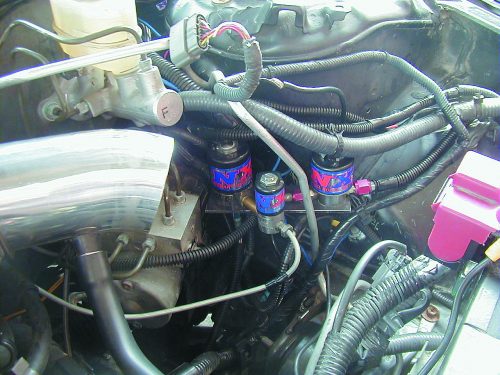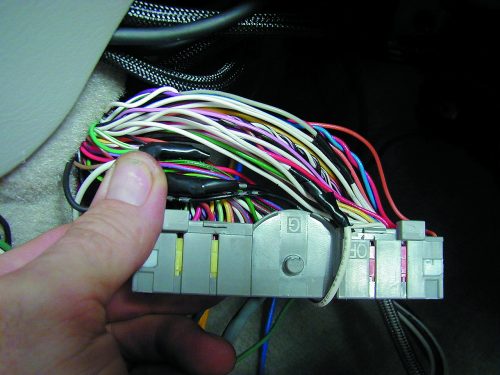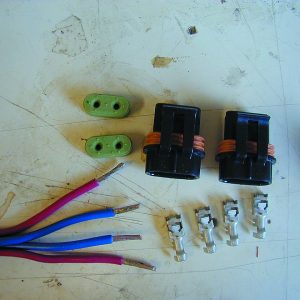How To Install The NX Maximizer
Nitrous oxide is a great performance enhancer. Itʼs relatively cheap, simple to use, and delivers the best bang for the buck hands down. Where else can you spend 500 bucks, make 35 hp to 75 hp to the wheels, then leave it idle and lying in wait until you need it again?
Despite these high-yield results, there are still enthusiasts who are gun-shy of using nitrous. Granted, there are a lot of lessons out there and tales of woe that describe the unlikely event of engine meltdown. These days, however, due to many nitrous companies spending far more resources on technical support and detailed installation literature, the proper knowledge is at our fingertips. There are also lots more great nitrous products available to make installation and usage much simpler.
The result of this increased popularity is that nitrous oxide is easier to accept for the average enthusiast. Far more tuners are installing these systems with far less fear of destroying their engines. Of course, you still must consider faulty installations and incorrect jetting patterns; so if you have a system installed, have it done by an experienced shop that knows the system, the basics of nitrous, and can share its knowledge with you.

The most common complaint voiced by owners of high-powered, nitrous-equipped vehicles is that the power comes on too strong, or the delivery is non-linear (unlike the power delivery of a turbo or supercharger system). When the power dumps on stream, as it does in these types of vehicles, it is sure to cause traction problems or even break driveline components. But before we go any further, itʼs important to understand that when the phrase “high-powered nitrous vehicles” is mentioned, we are referring to engines inhaling 100hp to 175hp doses of the stuff. When this much nitrous hits, sudden power increases do shock the driveline and can prove to be too much for gears or differential.
Remember that speed costs money, so how fast do you want to go? Traction is always a problem, as the more you power the car, the more tire you will need. And thereʼs nothing more frustrating than not being able to gain traction, which is why it is so common to lay rubber through three gears when the nitrous is activated. So be forewarned.
The vehicle featured in this article is a 2002 Nissan Maxima with an automatic transmission that has a two-stage Nitrous Express (NX) system, which is set up with a 50hp shot for the first stage, and 150hp shot for the second stage. When the system was activated in first gear, the car would lay rubber through the first three gears—which might be impressive to onlookers, but is not a good thing for acceleration. Since the whole point of installing a nitrous system is to go faster, something had to be done about the lack of traction.
While different brands of tires and suspension tweaks were experimented with, it appeared as if the only solution would be to run less juice. That, however, was unacceptable.

No, the answer to this problem was deeper. When discussed with NX, we found that the possible answer was its new and re-engineered Maximizer. The NX Maximizer was made by FJO Racing Electronics exclusively for Nitrous Express. Its state-of-the-art design is clearly evident in the flexibility of the unit and how it can be configured. Just about every feature that you need for flawless operation is built into this unit, including relays, window switch, throttle position sensor switch, wideband or narrowband O2 sensor output, transbrake signal, ignition retard output, data logging capabilities, plus a whole lot more.

But where the NX Maximizer really shines is in its programming capabilities. The Maximizer can be programmed using either a PC laptop computer or PDA, such as a Palm Pilot. Other progressive nitrous controllers on the market rely on dials to set and program the controller, whereas the Maximizer can be programmed to control the nitrous flow not only upon activation, but also for each gear, along with a ramping effect. The software that comes with the Maximizer is both clever and powerful, as it is able to identify each gear (either automatic or manual), and each gear can be configured for its specific amount of nitrous injection, as well as ramp level.
For example, if you wanted 35 hp worth of nitrous to come on in first gear and ramp up slowly to 75 hp in order to maintain traction, program it in. In second gear, the Maximizer could be set to 75 hp again, more aggressively ramping up to say, 150 hp, once the car stabilized and traction is obtained. This pattern could continue for as many gears as are in the transmission. By limiting how much nitrous is to be injected and the intensity by which it is introduced, you can reduce driveline failure and shock, as well as loss in traction.

The beauty of the programmability of the NX Maximizer is that several different programs can be saved and loaded with any configuration that you desire. You may want an aggressive program called “race slicks,” for when you are racing at the track on slicks. Thatʼs when you know you will have good traction, so you can program the Maximizer accordingly. You could also have a program called “race street,” if you happen to be rolling on drag radials in a street tire class, when traction is not quite as good as with slicks. You might need a smaller percentage of nitrous to be activated initially, or at a particular rpm, and then have it disengage once a turbo is fully spooled, or ramp up the power as you see fit. Repeat this process for every gear change with varying amounts of nitrous suited for your particular applications.
If drag racing isnʼt what you do, but you still like to use nitrous on the street, it would be possible to make several different street-oriented programs. The beauty of this system is that you no longer have to go under the hood to change nitrous and fuel-jet patterns, or to adjust the power output of your engine. Itʼs all done with a laptop (or PDA), and only takes about 2 seconds to load the desired program.

Data logging is also easy to operate, and the software time-stamps each session for easy identification and playback analysis. The data logger displays rpm, air/fuel, TPS voltage, gear position, nitrous percentage, as well as the arming switch position, trans-brake and ignition timing retard. All of these displays can help you fine-tune the performance of your engine while on nitrous. If the optional FJO Racing wideband unit is connected to the system, it can be used to further tune the engine, as well as double as a nitrous shut-off in the case of a lean condition.
Now, you may be wondering how it is that jetting doesnʼt have to be changed. Included with the kit is a solenoid driver that eliminates the need for wiring and mounting relays, which can be intimidating for some tuners. The solenoid drive regulates the amount of nitrous being injected by rapidly pulsing the solenoids. By installing jets that are of the maximum shot you want to run, you can, for instance, regulate a 200hp jet pattern all the way down to 20 hp (or 10 percent). For many enthusiasts, the fact that there are no jets to change is enough reason to purchase the Maximizer.
The flexibility to run nitrous oxide on any vehicle has always been a reality, but now itʼs a lot easier to run more nitrous without the worry of breakage. We documented the installation of the NX Maximizer when it was installed onto this Maxima, and we were quite surprised how straightforward the procedure was and how well it cleaned up the existing installation.
Article Sources
FJO Racing Electronics
204/254-5623
3311A Roblin Blvd. Winnipeg, Manitoba Canada R3R 0C2

 By
By 


















